Political campaigns (1945 onwards)
1945 campaign
With the establishment of the Federal Electoral Law of 1946, three political parties were registered: the Partido Acción Nacional, the Partido Democrático Mexicano and the Partido Revolucionario Institucional (successor to the Partido de la Revolución Mexicana). To improve control over the various factions within the Partido Revolucionario Institucional, President Manuel Ávila Camacho sought greater worker discipline and strengthened the popular side of the party in the same year that he restructured the official one by eliminating the military sector, in order to prevent internal conflicts prior to voting as had occurred with Almazán during the general elections of 1940.
In the election Miguel Alemán Valdés of the Partido Revolucionario Institucional received 1,786,901 votes (77.87%) and Ezequiel Padilla Peñaloza of the Partido Democrático Mexicano 443,357 votes (19.32%).
Miguel Alemán "Por la Grandeza de México"
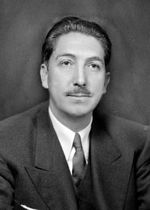
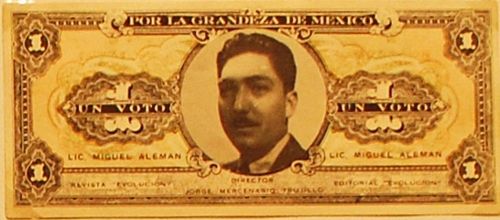
Bonos de la Democracia pro Lic. Ezequiel Padilla
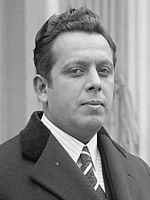 Ezequiel Padilla Peñaloza (31 December 1890 – 6 September 1971) served in the Senate, as Attorney General in 1928, as Secretary of Education from 1928 to 1930, as ambassador to Hungary from 1930 to 1932, and as Secretary of Foreign Affairs from 1940 to 1945 in Camacho's cabinet. With his co-cabinet member Miguel Alemán Valdés (Secretary of the Interior), he "gave Mexico the most progressive foreign policy and the most orderly internal government in the nation's history". By 1941, he had successfully settled all foreign claims against the government stemming from the Cárdenas-era expropriations. He negotiated a favorable economic treaty, fixed the peso to the United States dollar, and secured loans for industrial development from the Export-Import Bank of the United States.
Ezequiel Padilla Peñaloza (31 December 1890 – 6 September 1971) served in the Senate, as Attorney General in 1928, as Secretary of Education from 1928 to 1930, as ambassador to Hungary from 1930 to 1932, and as Secretary of Foreign Affairs from 1940 to 1945 in Camacho's cabinet. With his co-cabinet member Miguel Alemán Valdés (Secretary of the Interior), he "gave Mexico the most progressive foreign policy and the most orderly internal government in the nation's history". By 1941, he had successfully settled all foreign claims against the government stemming from the Cárdenas-era expropriations. He negotiated a favorable economic treaty, fixed the peso to the United States dollar, and secured loans for industrial development from the Export-Import Bank of the United States.
He emerged alongside Alemán as a prime contender for the presidency in 1946. He was better-known abroad than his rival, and was considered to have stronger tendencies toward democracy. However, his association with the United States made him unpopular in the left wing of the Institutional Revolutionary Party (PRI), and Alemán won the party's nomination. Padilla ran as an independent candidate, receiving 443,537 votes. Though Alemán received over three times the number of votes, Padilla's total was respectable, considering the PRI's hegemony at the time.
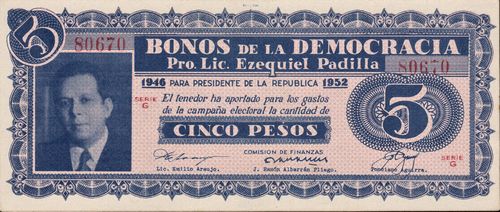
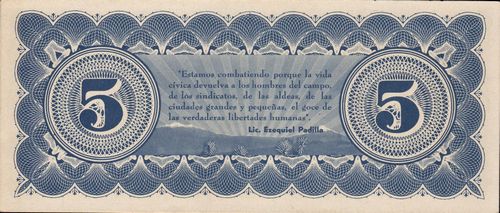
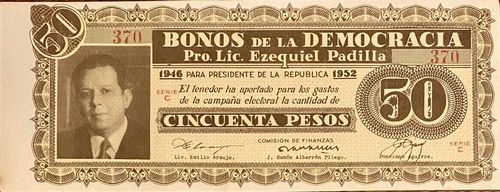
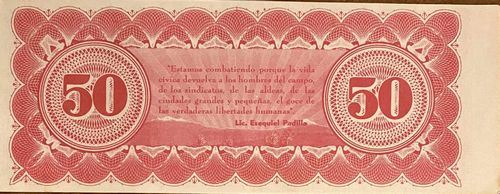
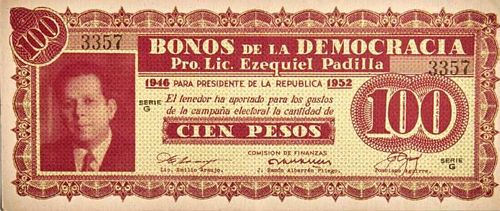
| series | from | to | total number |
total value |
||
| $5 | G | includes numbers 39519 to 37509 | ||||
| $50 | C | includes numbers 370 to 29845 | ||||
| $100 | G | includes numbers 3347 to 3357 |
These bonds have the printed signatures of Emilio Araujo, J. Ramón Abarrón Pliego and Ponciano Aguirre, comprising the Comisión de Finanzas.
|
In 1916 he was municipal president of Tuxtla Gutiérrez, and then tried unsuccessfully to be elected deputy to the Constituent Congress from 1916 to 1917; he was very close to president Venustiano Carranza and accompanied him until his assassination in Tlaxcalantongo. In 1917 he had been elected federal deputy for the first time, representing District 1 of Chiapas. After concluding his term, and being an opponent of the governments of Obregón and Calles, he spent the years from 1920 to 1937 in various commissions in Europe, including that of president of the Chamber of Commerce of Mexico City in Europe in 1927. He also held the positions of judge in Chiapas and legal advisor to the Department of the Federal District and established a law firm in partnership with Ezequiel Padilla Peñaloza. He was again elected as deputy for 937 to 1940 and then as Senator for Chiapas from 1940 to 1946. In 1945 he was legal advisor to the Mexican delegation to the San Francisco Conference, headed by Ezequiel Padilla. In 1946 he supported Padilla in his campaign as a candidate for President, becoming vice-president of the PDM. He then retired to the exercise of his profession until his death on 23 October 1953. |
 |
| J. Ramón Abarrón Pliego |  |
| Ponciano Aguirre | 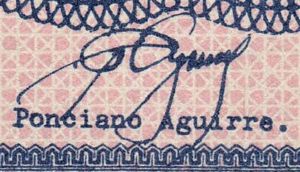 |
Confederación de Trabajadores de México
The Confederación de Trabajadores de México (Confederation of Mexican Workers) was founded on 21 February 1936, during the term of President Lázaro Cárdenas. Cárdenas saw an organized labour sector as being essential to the goals of his government and so pushed for the formation of this new umbrella labour organization. The CTM (along with the Confederación Regional Obrera Mexicana (CROM) and the electrical workers union) formally aligned with the Partido Revolucionario Mexicano, the predecessor of the Partido Revolucionario Institucional, as its "labour sector" in 1938, and so became effectively part of the state.
We know of a $1 bond[image needed] dated 12 September 1960.
On 4 August 1961 Heriberto Jara opened the constituent assembly of the Movimiento de Liberación Nacional, an independent organization that brought together almost the entire Mexican left to fight for national sovereignty, economic emancipation, solidarity, democracy and peace, and "to face the most serious and least artificial problem of our time, such as imperialism."
The Movimiento was born as a response to the repression of the government of Adolfo López Mateos to the peasant groups and the workers' and teachers' unions, and was encouraged by the fact that in Cuba a group of young people had managed to take power by arms and establish a socialist society in the middle of the Cold War.
In response, on 24 August the right wing forces in the country formed themselves into the Frente Cívico Mexicano de Afirmación Revolucionaria.
Frente Cívico Mexicano de Afirmación Revolucionaria
Former president Miguel Alemán founded the Frente Cívico Mexicano de Afirmación Revolucionaria to oppose the Movimiento de Liberación Nacional launched by Lázaro Cárdenas in 1961. The Frente Cívico Mexicano sought to give substance to the right-wing slogan: “Catolicismo sí, comunismo no,” joining forces with business leaders from Puebla, Monterrey, and Mexico City, the Partido Acción Nacional, and remnants of the Cristero movement, namely the Unión Nacional Sinarquista.
Known denominations include $50 and $100 pesos.
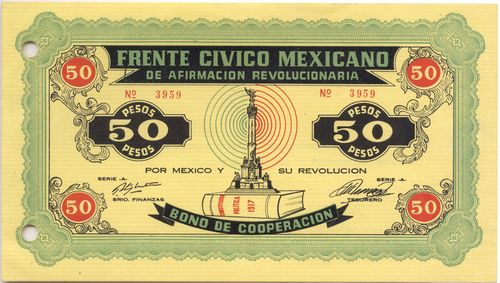
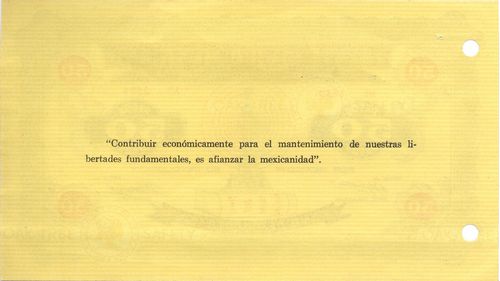
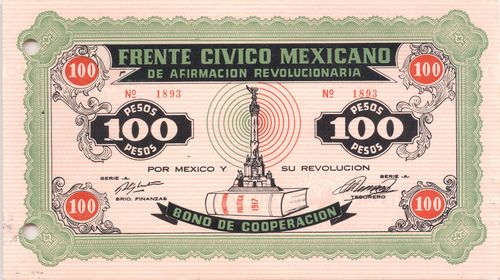
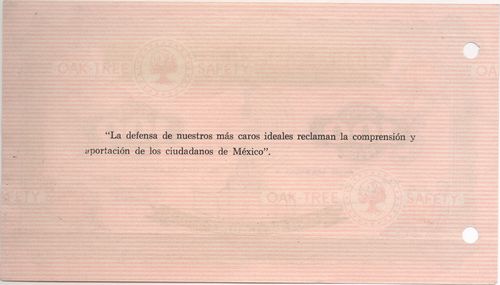
| series | from | to | total number |
total value |
||
| $50 | A | includes numbers 3959 to 3960 | ||||
| $100 | A | includes numbers 1893 to 1896 |
Federación de Obreros y Campesinos del Estado de México
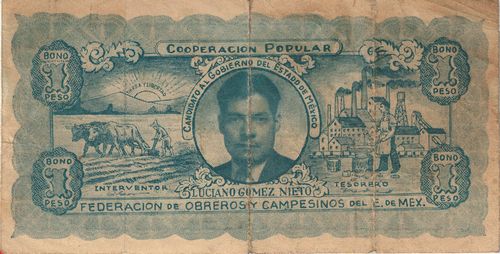
Luciano Gómez Nieto was a candidate in the 1962 election of the governorship of the Estado de México.
To be dated
Banco Plan de Ayala
This $100 bond is from Cuernavaca, Morelos
Partido Comunista de México
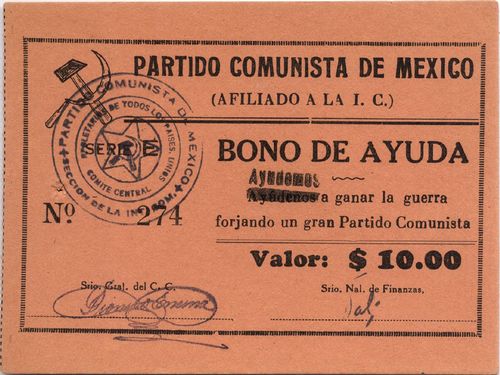
| series | from | to | total number |
total value |
||
| $10 | E | includes number 274 |
This bond has the signatures of Dionisio [ ][identification needed] as Secretario General of the Comité Central. and [ ][identification needed] as Secretario Nacional de Finanzas.
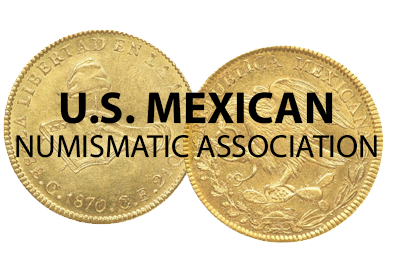
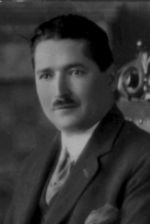 Emilio Araujo y Araujo was born on 9 August 1892. He graduated in Law from the National University of Mexico, having studied from 1913 to 1917.
Emilio Araujo y Araujo was born on 9 August 1892. He graduated in Law from the National University of Mexico, having studied from 1913 to 1917.